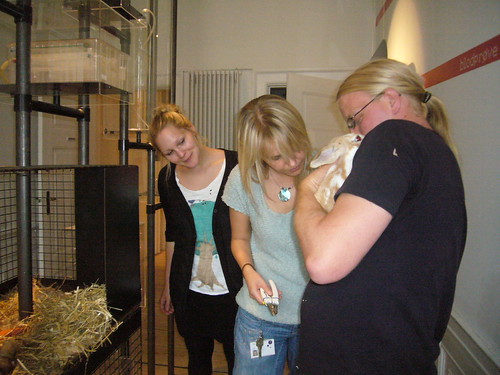
Maintaining an exhibition like ‘Split and Splice: Fragments from the age of biomedicine’ is quite a job. Not many of us who frequently visit museums consider the time and effort put into maintaining the shows that we visit. We kind of take it for granted that the display cases are polished and we properly rarely think about it – unless the general maintenance is lacking.
Admittedly maintaining a show can sometimes be a tedious job but never the less it is extremely important. Changing light bulbs and keeping the dust levels down are some of the more mundane tasks but as Split and Splice is a special exhibition – it also requires special maintenance. Especially the two stars of the show, the rabbits Split and Splice named, of course, after the show itself. Deciding to have live rabbits in the show was a long process and something that we discussed over and over again. Knowing fully well that having rabbits in the exhibition required special care we decided to go through with it. Feeding the rabbits, cleaning their cage, ensuring a steady supply of hay, ensuring that the room temperature is at an acceptable level are just some of the challenges we face every day – and the rabbits are alive and kicking. Especially the younger audience seem to be responding well to the presence of live animals within the show. Just the other day a couple of sixth graders had had enough of the (admittedly) sometimes frightening stories of medieval surgery and had retreated to the front lobby of the Museion were I found them while going through the exhibition showrooms. Introducing the kids to Split and Splice immediately cheered them up and turned what could have been a bad museum experience into a positive one.
Anyways … maintaining the rabbits requires special care which is why we have just had a visit by veterinarian Camilla Schumacher-Petersen and her assistant Kirsten Rosenmay Jacobsen (both from The Department of Experimental Medicine, University of Copenhagen). There had been no indication of any health problems what so ever but I very much wanted a professional opinion just to be sure. Camilla inspected both Split and Splice and found them to be in good shape. She cut their nails and was all in all satisfied with their living conditions.
Maintaining ‘Split and Splice: Fragments from the age of biomedicine’
Maintaining an exhibition like ‘Split and Splice: Fragments from the age of biomedicine’ is quite a job. Not many of us who frequently visit museums consider the time and effort put into maintaining the shows that we visit. We kind of take it for granted that the display cases are polished and we properly rarely […]


